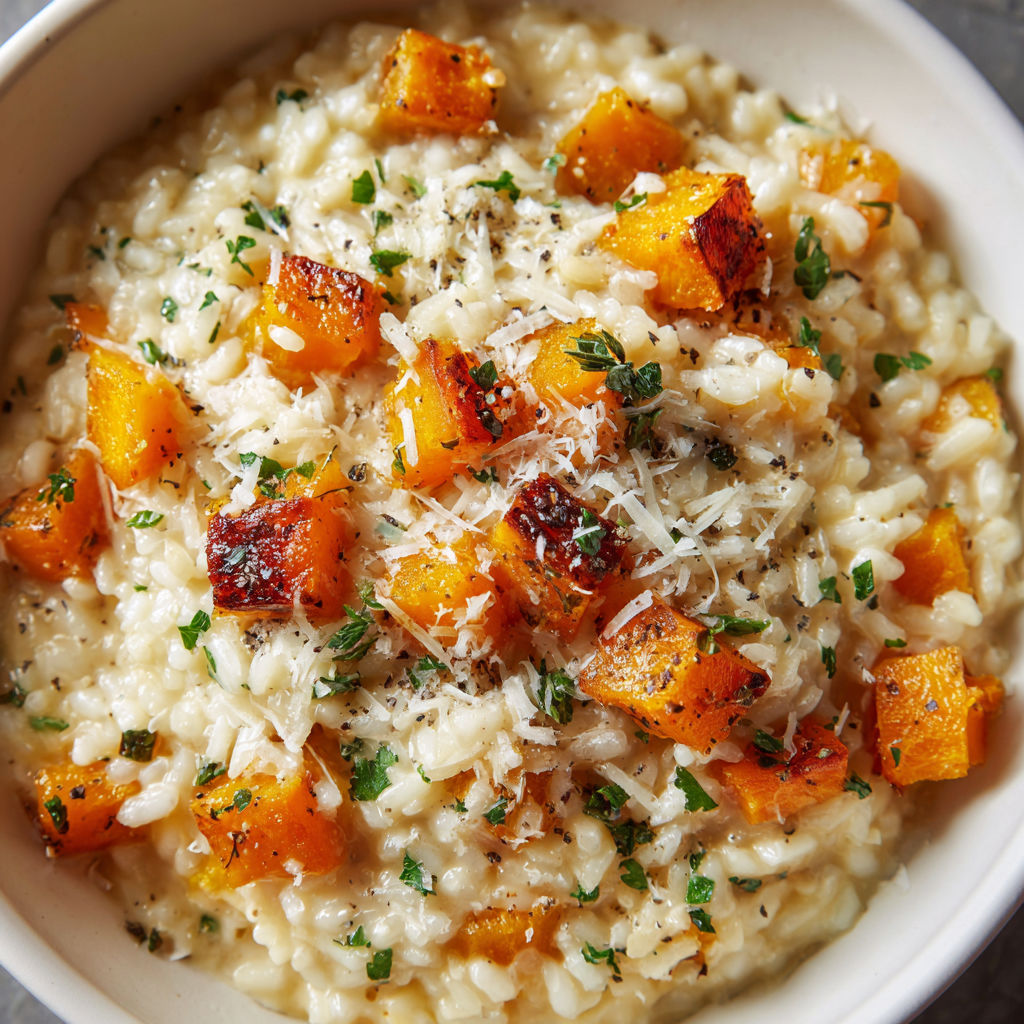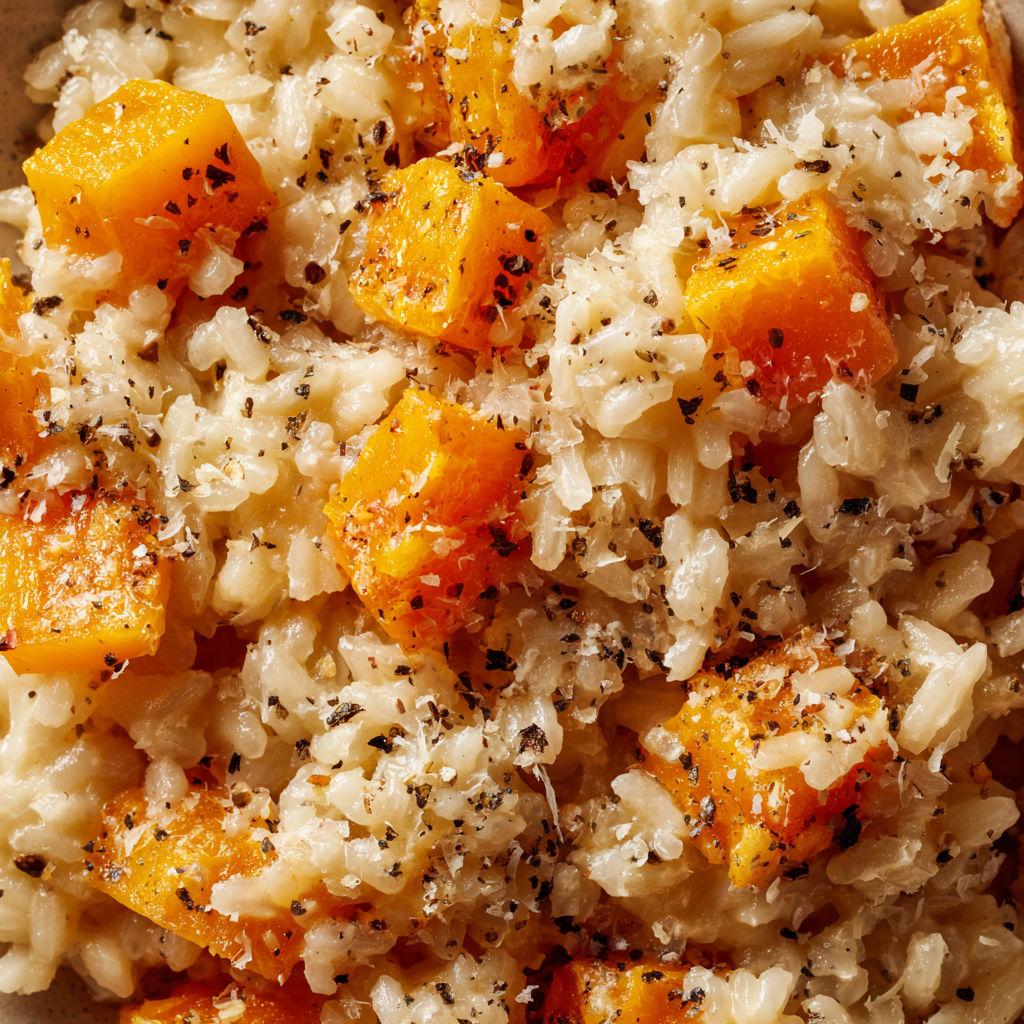 Save to Pinterest
Save to Pinterest This creamy butternut squash risotto brings together sweet roasted squash and nutty Parmesan for a deeply comforting meal that tastes like fall in a bowl. Every bite is silky and rich with just the right balance of earthy vegetables and umami. When I first tried this version on a chilly evening, I immediately knew I would be making it every autumn once squash arrives at the market.
I love how this risotto uses only a handful of real ingredients to create something so layered and flavorful. My family always requests this dish when they see butternut squash in my kitchen.
Ingredients
- Arborio rice: This is classic Italian risotto rice with a creamy texture and defined bite. If you can find carnaroli, it works too.
- Vegetable broth: Adds savory depth and complexity. Use a good quality low sodium broth for best results.
- Roasted butternut squash: Fresh and sweet. Choose squash that feels heavy for its size with a deep orange flesh.
- White wine: Optional, but it brightens and balances the flavors. Use something dry you would enjoy drinking.
- Onion: Adds subtle sweetness and a savory foundation. Look for firm onions with papery skins.
- Garlic: Gives a fragrant flavor base. Fresh cloves make a big difference here.
- Grated Parmesan: Salty and nutty. Only use real Parmigiano Reggiano if possible. Grate it yourself for best melt.
- Butter: Brings luxurious richness and helps sauté the aromatics. Choose good European style butter if possible.
- Salt and pepper: Essential for bringing all the flavors together. Taste as you go for seasoning.
Instructions
- Sauté the Aromatics:
- Melt the butter over medium heat in a large heavy pan. Add diced onion and a pinch of salt. Sauté gently for 5 to 8 minutes until the onion turns translucent and soft. Stir in the minced garlic and cook another minute until fragrant but not browned.
- Toast the Rice:
- Add the Arborio rice directly to the pan. Stir it constantly so each grain is coated in melted butter. Keep stirring for 1 to 2 minutes until the rice is turning opaque and you can smell a faint toasty aroma. This short step helps the risotto absorb flavor and creates its signature texture.
- Deglaze with Wine:
- Pour in the white wine if using. Let it bubble up and stir until almost all the liquid disappears. The wine adds acidity and depth while deglazing any browned bits from the onions.
- Add Broth Gradually:
- Start adding the warm vegetable broth one ladle at a time. Stir frequently. Wait until each addition of broth is nearly absorbed before adding the next. This should take about 20 to 25 minutes. All the grains should be creamy but slightly al dente at the center.
- Stir in Squash and Parmesan:
- Gently fold in the roasted butternut squash cubes and most of the grated Parmesan. Save a bit for the top. The squash should break up slightly for extra creaminess but keep some pieces whole for texture.
- Finish and Serve:
- Taste the risotto. Add more salt and pepper as needed. Spoon into shallow bowls. Top with remaining Parmesan and serve right away while piping hot.
 Save to Pinterest
Save to Pinterest My favorite part of this recipe is always the aroma when the butter hits the pan with onion and garlic. It is the signal that something comforting is on its way to the table. This dish has become our celebratory meal for the first crisp fall evening each year.
Storage Tips
Leftover risotto keeps well in sealed containers in the refrigerator for up to three days. I reheat it gently with a splash of broth or water in a saucepan to loosen it up and revive its creaminess.
Ingredient Substitutions
For a dairy free risotto, use olive oil instead of butter and swap Parmesan with nutritional yeast or a plant based cheese blend. You can use acorn squash or pumpkin cubes instead of butternut squash if desired, and chicken broth works just as well as vegetable.
Serving Suggestions
Serve this risotto as a main dish with a side salad or pair it with roasted chicken or fish. For an extra special touch, sprinkle crispy sage leaves or toasted pine nuts over the top.
Cultural Context
Risotto comes from Northern Italy and is beloved for its versatility. Arborio rice absorbs flavors readily, which makes it perfect for the fall flavors of sweet squash and nutty cheese.
Seasonal Adaptations
Choose butternut squash at its peak in autumn. Swap in roasted pumpkin or sweet potato for a winter spin. Try adding a handful of baby spinach or peas in spring for extra color.
Success Stories
Every fall my friends ask for the recipe after our cozy risotto dinner party. I have even adapted it into appetizers by shaping chilled risotto into balls, rolling in breadcrumbs, and frying for homemade arancini.
Freezer Meal Conversion
Risotto is at its best fresh, but you can freeze portions flat in ziptop bags and thaw overnight. The texture may change a little so I recommend reheating on the stove with a splash of broth and lots of stirring until creamy again.
 Save to Pinterest
Save to Pinterest Nothing transforms a simple dinner quite like a batch of risotto. I always find the process meditative and am rewarded with a meal that draws everyone to the kitchen.
Common Recipe Questions
- → Can other types of rice be used?
Arborio rice is best for creamy texture, but Carnaroli or Vialone Nano are suitable alternatives.
- → How do I ensure risotto is creamy?
Stir frequently and add warm broth gradually to coax out the rice's natural starches, ensuring a creamy consistency.
- → Can this dish be made dairy free?
Yes, substitute plant-based butter and omit Parmesan, or use a vegan alternative for cheesiness.
- → Is it possible to add extra vegetables?
Absolutely! Spinach, peas, or mushrooms can be stirred in for added color and flavor complexity.
- → What herbs complement the flavors?
Sage or thyme work particularly well, adding fresh, aromatic notes to the finished dish.